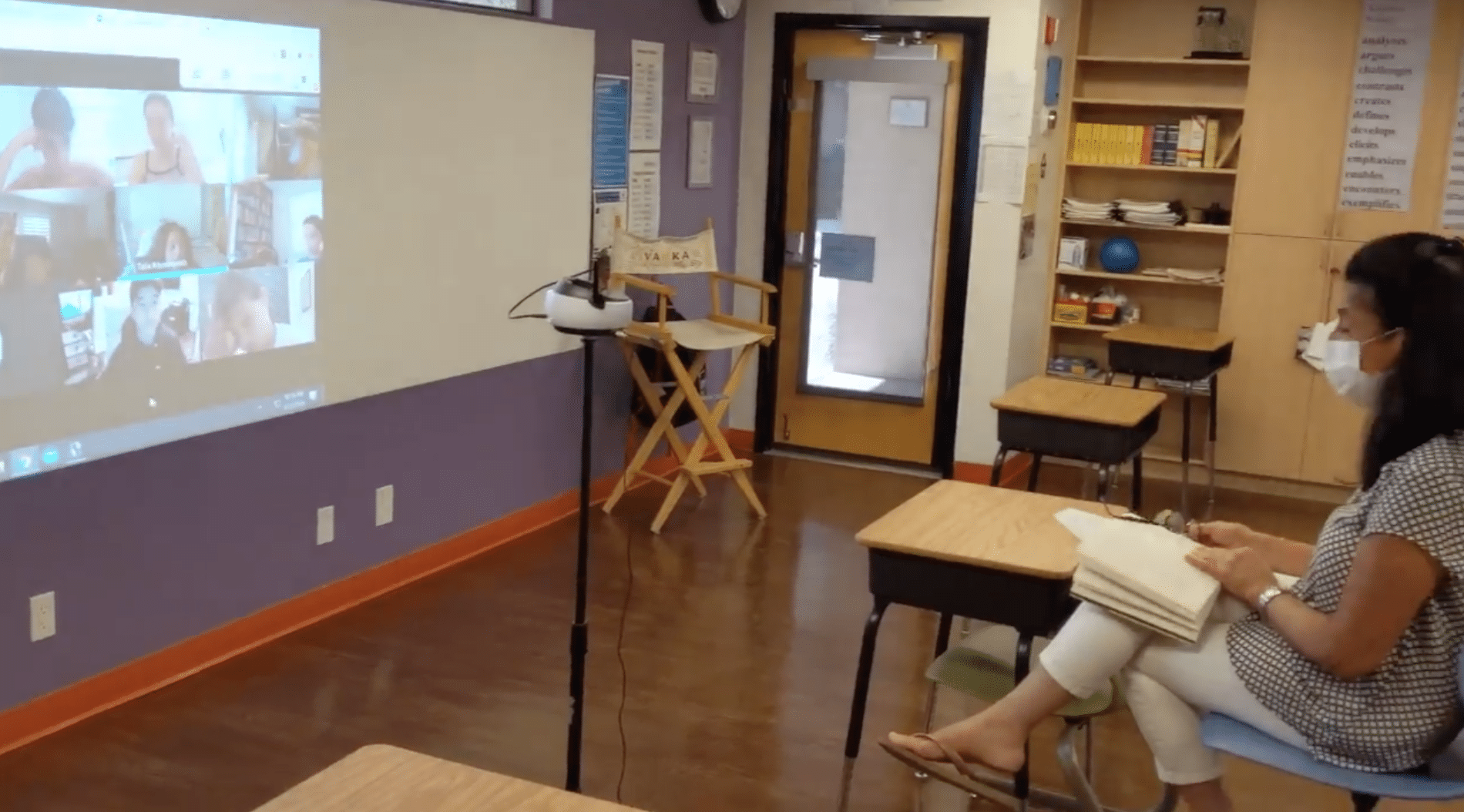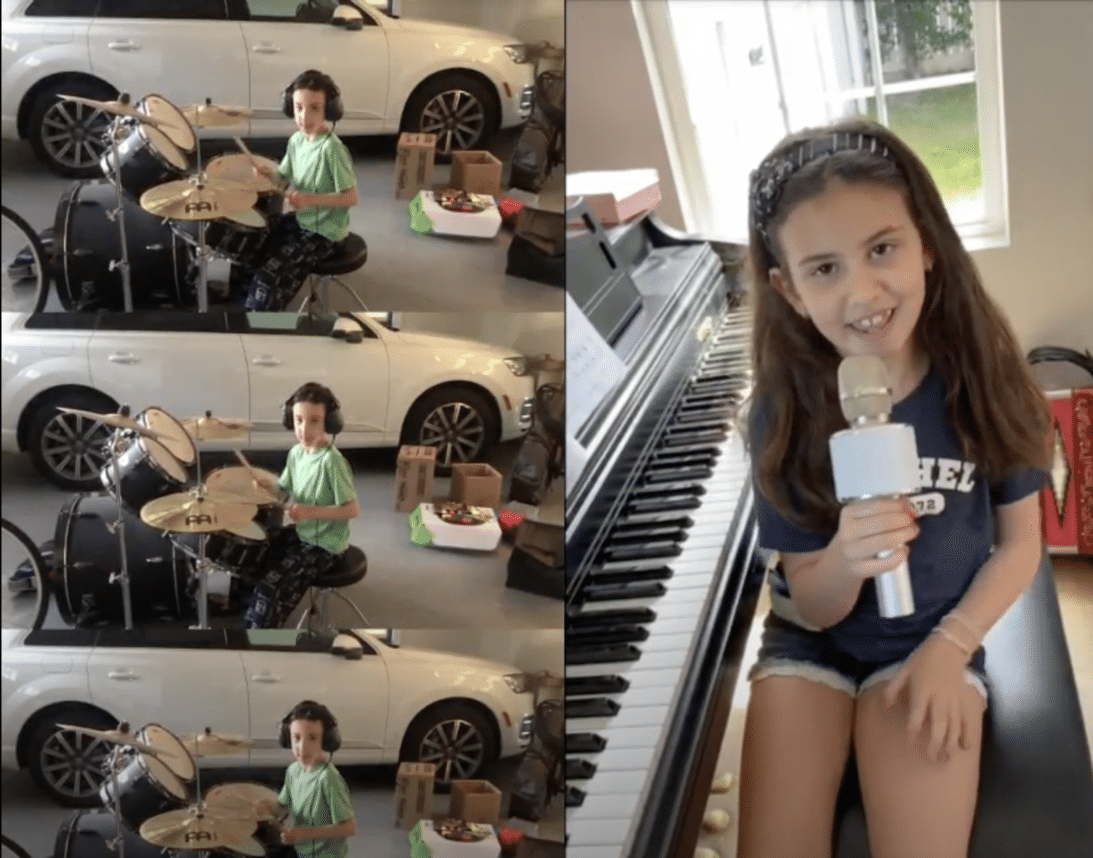 Students and staff at Abraham Joshua Heschel Day School have become experts in “distance learning.” Photo courtesy of Abraham Joshua Heschel Day School
Students and staff at Abraham Joshua Heschel Day School have become experts in “distance learning.” Photo courtesy of Abraham Joshua Heschel Day School
Most local private schools, including Jewish schools, resume at the end of August. But this year is anything but normal. Principals and administrators have spent much of the summer ironing out multiple plans to return, whether in-person, online, or some combination of the two. That’s because no one knew whether kids would be back in school; in school but in smaller groups; in ‘pods’ as they are known; or ‘distance learning’ from home.
As of press time, it was expected that all students in first through 12th grades would start the year at home. (Kindergarten students are legally allowed to learn in-person but it is up to individual schools whether to do so). Fortunately, schools have had several months of practice with distance learning.
That wasn’t the case back in March when the coronavirus shut down everything. “We quickly pivoted in the springtime to virtual VBSDS, our virtual platform for school, which was designed in about 48 hours, the same as all the other independent schools,” Rabbi Deborah Schuldenfrei, head of school at Valley Beth Shalom Harold M. Schulweis Day School in Encino, told the Journal. “It was almost like a yetziat Mitzrayim (leaving Egypt) moment. Like we had to just make sure everyone made it to the sea.”
Now, the VBS faculty, like so many others, are veterans of online teaching. They, along with the administrators, also have had time to reevaluate the schedule that originally was created under less than ideal conditions.
“We really believed the most important thing was to have as much synchronous learning as possible,” Schuldenfrei said. (Synchronous learning refers to live virtual lessons usually with one’s teacher and classmates as opposed to recorded lessons.) “We didn’t think as much about built-in snack breaks and naming it that. So, we’re going to be building a schedule that consciously aligns those things we learned from the spring. Because as much as we loved having so much synchronous learning, it’s also a problem having a kid on screen from 8 to 1:45.”
In a letter sent to families earlier this month, Schuldenfrei wrote, “We learned that we need to balance our students’ minds, bodies and souls. … We will encourage ‘brain breaks’ and movement.” (Brain breaks, she explained to the Journal, are movement-based activities such as simple dances or short walks “designed to get the blood flowing and heart pumping so that we maximize our learning power.”)

Abraham Joshua Heschel Day School in Northridge has committed to “create opportunities of small group instruction” by using Zoom breakout rooms, Head of School Larry Kligman told the Journal. He gave the example of a seventh-grade math class to illustrate the importance of small-group work, stating that teaching math to 16 seventh-graders online is not the same as teaching 16 seventh-graders in the classroom.
“In school, when they are working on their math problem, [the teacher] can walk around the room and kind of watch what they are doing. They can see: This kid has it, this kid is struggling. On Zoom, unless [students] hold their paper up, it would be kind of hard.” Breakout rooms, he said, make it easier for teachers to provide individualized attention. There also are additional benefits to breakout rooms, Kligman said. “So much of our curriculum is about collaboration and critical thinking and you really need to be in small groups to do that.” The school also will be instituting online teacher office hours in the fall, he added, so students “can get that immediate feedback.”
“So much of our curriculum is about collaboration and critical thinking and you really need to be in small groups to do that.” The school also will be instituting online teacher office hours in the fall “so students can get that immediate feedback.” — Larry Kligman
Wise School in Bel Air is doing something similar. “Every day will end with half an hour of study hall and teacher office hours so students have a chance to do some homework and ask questions,” Wise Head of School Tami Weiser told the Journal. The period will likely be optional for students.
Other changes Wise has made since the spring include “a much more structured schedule for all grades,” Weiser said, with everyone taking recess and lunch at the same time. This, she explained, will allow families with multiple kids at the school to stop and take breaks at the same time.
Wise School students also will be required to wear their school uniforms during the school day, which wasn’t the case in the spring. “It sort of speaks to the tone of learning,” Weiser said. “Kids would ‘come’ to school in various states of dress. We want them to know they are in school. So, there’s no costumes, no pajamas.”
The hope, Wesier said, is that these changes “will normalize the school day for everybody.”
At Shalhevet High School in the Pico Fairfax neighborhood, the spring term provided multiple takeaways related to distance learning. “Changing the way we think about homework and assessments was something that was really helpful,” said Associate Head of School Rabbi David Block, adding that it was student feedback that led a closer look at homework load.
Block also noted that most teachers were likely assigning the same amount of homework as usual, though some may have been giving slightly more, thinking kids were stuck at home anyway. However, at the grade level meetings the school regularly hosts to “check in” with students, a significant number expressed feeling overwhelmed. Especially with all the stressors around the pandemic, Block said this was “really important for us to hear,” and as a result, “we had conversations with faculty.”
The school also put a lot of thought into what testing would look like. “How do we ensure academic integrity?” Block said. “Our students are pretty good with that. But you have to be concerned about that in any school.”
He also noted that some schools with which he was in contact planned to use software that shuts down student access to all other resources during test taking, or requires students to turn their computer cameras on during tests. But Block and his colleagues felt these were not only extreme measures, but “probably would not create a great feeling with students. Instead, we decided to focus largely on different forms of assessments that weren’t tested,” such as portfolios, research projects and presentations that “tend to assess for higher levels of thinking.”
Schools also are investing in programs to give teachers more tools and students more opportunities to learn and grow. Wise School for example recently purchased IXL, an online education platform. Several schools have partnered with Treedom — a platform that enables students to find community service opportunities that speak to them and keeps track of their participation, although the company doesn’t use the term “community service.” Founder Michael Kadisha, a graduate of Milken Community Schools, suggested that term doesn’t always have positive connotations for young people.

“We followed the principles of TikTok and gamified it,” Kadisha said. “We want to make community engagement interesting for students.” Among the Los Angeles Jewish schools using Treedom are YULA Boys and Girls High Schools and Kadisha’s alma mater, Milken, which just signed on.
Of course, the 2020-21 school year presents at least one very new challenge, said Marc Lindner, the new head of school at Sinai Akiba Academy in West Los Angeles. (Lindner, a New York native, was most recently associate head of school at a Jewish day school in Maryland.)
“Our school theme for this year is chazak v’ematz. (strong and resilient). And so, I hope that this is the year that we teach kids and adults you’re strong and you’re resilient, because this is really all about being that and knowing how to keep changing and keep growing.” — Tami Weiser
“Last spring, we started the school year in a normal way, went through about three-quarters of the school year and then had to very quickly pivot and shift to a new thing, but they all knew one another,” Lindner said. “Now — and this is true for all schools — we are all faced with kids and teachers forming relationships without being physically present together. That’s a major difference. That’s what we’ve been thinking about: to be as careful and thoughtful and deliberate about that.”
He added, “Educators know that students learn best when they trust the teachers. That’s why the relationship formation is really crucial. Usually that’s when students feel like they can take some risks and do things that are out of their comfort zone. This is why we’ve got to make sure that we’re thinking about how much time do we have to take, what are good ways, activities, etc., to help them form the relationships, build trust, so the learning can take place.”

It’s not just students and teachers being impacted by the switch to virtual learning. Schools regularly host popular community events for parents and families but when they began distance learning in the spring, the calendar emptied out. The absence was felt.
“We were losing community,” Kligman said. “We realized that this is our opportunity to redefine the word ‘community.’ Community doesn’t necessarily mean you have to physically be together.” So Abraham Joshua Heschel School scheduled several events including a challah baking lesson, an Israeli dance session and multiple game nights — all virtual. “I think our highest was [having] 90 families participate,” Kligman said. They even had an all-school Shabbat the last Friday of the school year, with parents, staff and administrators delivering Shabbat boxes to every household. They plan to continue similar community events in the fall.
Because schools did so much advance planning for every imaginable scenario over the summer, the school leaders who spoke with the Journal all indicated they feel ready to switch to in-person learning when they get the green light. Several schools were expecting to be fully in-person at the start of the school year as recently as early August thanks to a waiver offered by the state for elementary schools.
However, on Aug. 4, the Los Angeles County Department of Public Health announced that because of high COVID-19 rates, it would not consider any waiver applications.
Among the modifications schools have made for the return of students to campuses is spacing desks at least six feet apart, planning for smaller class sizes and repurposing rooms and campus spaces. At Heschel for instance, “where it used to be a classroom of 16, is now only a classroom of 11,” Kligman said. He added that the dance room and music room have been converted to classroom spaces.
“Dance can now be outside,” Kligman said. Students will continue to study music in their respective classrooms.
Some schools also have invested in new technology that will enable teachers to bring their classroom lessons into students’ homes. This is distinct from Zoom. Wise School, for example, purchased 16 Meeting Owl cameras (a 360-degree smart videoconferencing camera). Heschel invested in something similar for every classroom.
According to Weiser, teachers at Wise School will have the option of using the Meeting Owl cameras even during distance learning — teaching from their regular campus classrooms, albeit classrooms without students.
Said Kligman, “When we do have the option of being on campus and feel like we are meeting the guidelines of our county and the CDC (Centers for Disease Control and Prevention), for families that don’t want to partake in that, they can have the option of we’re going to be able to livestream the class to the home. For the kids, they will be able to be live [and] interactive, seeing the teacher, seeing their classmates, being able to be part of the group discussion.”
Kligman also is hopeful that this option will make it easier for parents to keep kids home when they aren’t feeling well. It will take the worry about missing class and falling behind out of the equation. And lastly, if a student or student’s family member does contract COVID-19 and is required to quarantine, they can still attend class from home.
As the start of the school year looms, the schools are aware that there are still a lot of unknowns. “It’s a very fluid situation,” Kligman said. “We realize as a school that whatever plans we have in place … may not be how we open. And whenever that first day of distance learning is, or whenever that first day of in-person instruction is on campus, I imagine two weeks later, four weeks later, we’re already at plan C.” Nonetheless, he added, “this is not a time to feel discouraged. This is a time to connect. I keep on using that word. That’s my magical word.”
“Like everything we’re learning with this, it’s flexibility and adaptability,” Weiser said. “Our school theme for this year is chazak v’ematz. (strong and resilient). And so, I hope that this is the year that we teach kids and adults you’re strong and you’re resilient, because this is really all about being that and knowing how to keep changing and keep growing.”






















 More news and opinions than at a Shabbat dinner, right in your inbox.
More news and opinions than at a Shabbat dinner, right in your inbox.